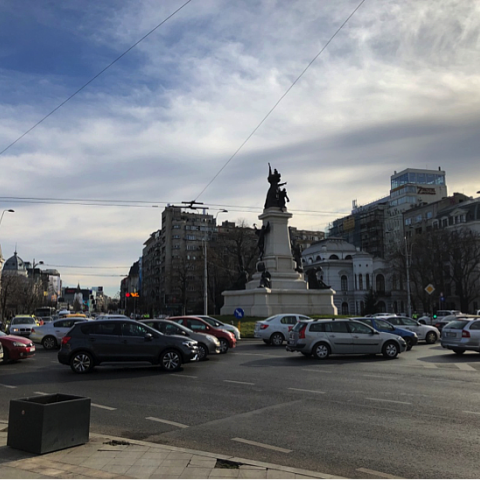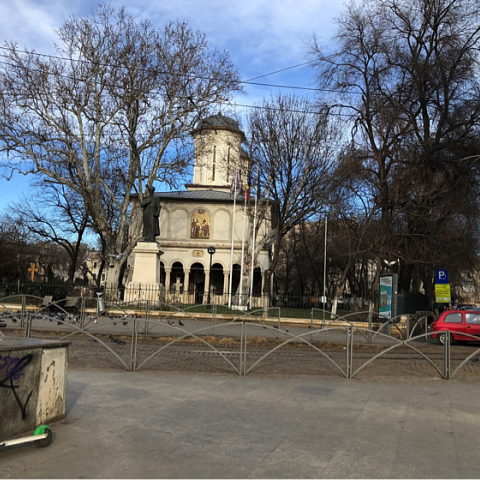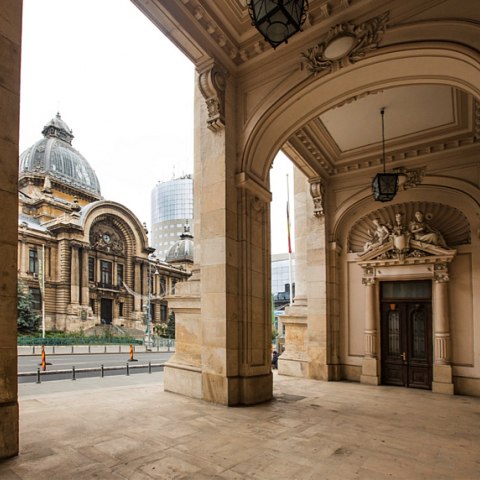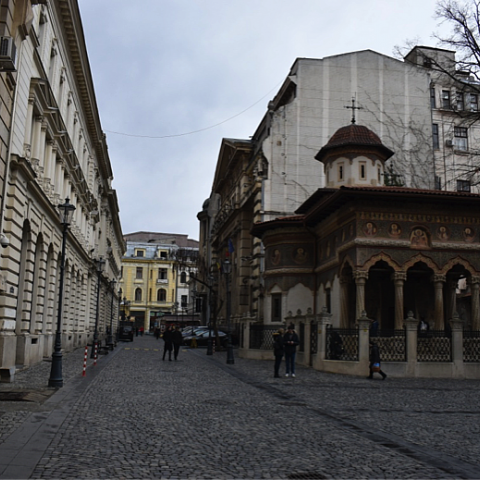"Destination: Bucharest" - A walk in the Old Town
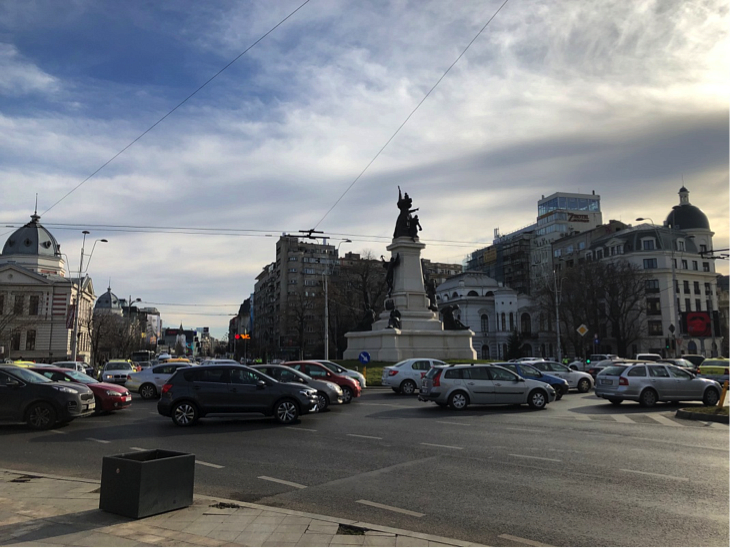
Ion C. Brătianu Boulevard, which links University Square to Unirii Square, divides the historic center of the Capital into two halves: one is boisterous, bustling and crowded, while the other is quieter, but ready to receive more attention from visitors. Both are part of the nucleus that formed around the old princely court, an area where, in time, picturesque slums and prosperous commercial streets developed. On a sunny, early spring day, let’s go on a walk on the narrow streets of the historic center to discover its old stories and eclectic charm.
Often, the Old Town is associated with the area where the Old Princely Court Palace is located, but its perimeter stretches wider. We start our journey at the University round, the meeting place of Regina Elisabeta and Carol boulevards, which form the northern limit of the historic center, up to the intersection with Calea Victoriei to the west and Hristo Botev Boulevard to the east. There, Colțea Church stands on one side. It is one of the oldest edifices of the city still standing and used to be part of the old Colțea district. It was built in a predominantly Brâncovenesc style and was documented at the beginning of the 18th century. It was made by constable Mihai Cantacuzino, whose statue can be found in the courtyard of the Colțea Hospital, another project of his, located initially in the courtyard of the Colțea Monastery. The Colțea Inn used to stand in the area, built to supplement the revenues of the monastery, and the Colțea Tower was also built nearby. At the height of 50 meters, the tower, today gone, was the tallest construction in the city between the 18th and the 19th centuries.
Behind the Colțea Hospital stands the Scaune Church (The Church of the Chairs), once located in the old slum of the butchers and soap makers. The church got its name from the guild of the butchers, whose chairs, namely the logs they used as a surface for cutting the meat, were placed. The church was also supported by the guild of the soap makers, who used the fat from the animals in the production process. The church was built in 1705, replacing an older, wooden one.
Advancing towards Unirii Square, on the same side of the Brătianu Boulevard, we find the Sfântul Gheorghe Nou Church, the last known edifice erected by Constantin Brâncoveanu, a prince of Wallachia between 1688 and 1714. It is also the place where his remains are interred. The church is surrounded by a small park, with old plane trees. The park also hosts a statue of Constantin Brâncoveanu, made by Oscar Han, and the Zero Kilometer Monument, conceived by architects Horia Creangă and Ștefan Niculescu and designed by sculptor Constantin Baraschi in 1938. It’s a quiet area, with its air as if coming from a different realm, even if it stands just near a broad boulevard, often crowded, and near a tram station where hundreds of people come and go every day.
A little further up from Sfântul Gheorghe Church, towards the Cocor store, Bărăţia Church, the oldest Roman-Catholic church in Bucharest, can be found. With its entrance straight towards the street, the church often attracts tourists thanks to its massive shape. Those who venture further on the streets surrounding the Cocor store will find, on Patria Street, the Elias-Patria Inn, dating back to the 19th century. The inn preserves a large part of its original aspect, with the windows with Ottoman-style influences.
From Patriei Street we enter Baia de Fier Street, which leads us to Sfânta Vineri Street, where we find the Coral Temple. Built in 1866, in a Neo-Moorish architectural style, it is a replica of the Leopoldstädter Tempel synagogue in Vienna, destroyed by the Nazis. In front of the temple, a menorah-shaped monument has been placed to commemorate the victims of the Holocaust. The temple is over 150 years old, but the presence of the Jewish community in the city has been documented from an earlier period. The building was restored în 2015 and can be visited daily during the morning (except for Saturdays) – it is also rather popular among foreign tourists. On the inside, the building is even more spectacular than on the outside – with stained glass and frescoes.
The streets around the Sfânta Vineri Square used to encompass a part of the former Jewish neighborhood of the city, and, in time, the households of the community expanded towards Văcărești-Dudești, Calea Rahovei, and Calea Moșilor.
From the Coral Temple, we take Corneliu Coposu Boulevard and enter Hristo Botev Boulevard, the eastern limit of the historic center. The artery hosts several buildings that have been added to the list of the historical monuments. Among them, the Nicolae Krețulescu Commercial School finished in 1890 according to the plans of architect P. Petricu; the Solly Gold Block, designed by architect and artist Marcel Iancu; the Astra Română Society Block in Rosetti Square, one of the first modern-style blocks erected in the city at the end of the 19th century; and Societatea Locuinţe Ieftine (Affordable Residences Company) Block, designed in 1926 by architect Virginia Andreescu Haret.
From Rosetti Square, we head towards Colțea Park, cross the University underpass, get out on one side of the Bucharest Municipality Museum, take the Ioh Ghica street. In no time, we find ourselves on Smârdan Street, on one side of the Palace of the National Bank of Romania (BNR), in the noisy and jolly half of the historic center, most often referred to as the Old Town.
The BNR Palace was erected at the end of the 19th century, on the plot of land previously taken up by Șerban Vodă Inn, built between 1683 and 1685, during the rule of Șerban Cantacuzino. It was the leading inn of the city for a long time because of its size and the safety it provided. On the Lipscani side of the palace, some of the ruins of the inn can still be seen on display beneath a glass covering. Impressive both on the outside and on the inside, the palace hosts the National Bank of Romania and the BNR Museum, with its numismatic collection covering a period of over 2000 years.
We recommend you visited this museum: the tour takes about an hour and you have to schedule it în advance, online. You can find more info for the schedule here. You will discover an impressive coin collection, many gold coins, and curiosities, and you will learn exciting things about the building.
Another side of the palace faces the street that carries the name of the BNR founder Eugeniu Carada, an artery from where the two arms of the Macca Vilacrosse passage start. The glass-covered arcaded street is the work of architect Felix Xenopol and was inaugurated in 1891. Today, it is filled with coffee shops where tourists can stop for a break from sightseeing but also admire this architectural jewel linking the Old Town to Calea Victoriei.
Across the street from the BNR Palace, we find the palace of the former Dacia Insurance Company (Societatea de Asigurări Dacia). Framed by Lipscani and Stavropoleos streets, the monumental edifice will host the future HQ of the Bucharest Municipality Pinacotheque. The palace, built between 1910 and 1913, is richly decorated, and architecture or photography lovers will have many details to discover here, between arcades, colonnades, busts and various statues that embellish the edifice.
We cross from Lipscani over to Stavropoleos, advance past the future HQ of the Pinacotheque and discover across the street the palace of the former Romanian Credit Bank (Banca de Credit Român), built at the beginning of the 20th century by architects Oskar Maugsch and Ernst Gotthilf. Next to the palace, we find one of the most visited sites in the Old Town, the Stavropoleos Monastery, an architectural monument of Brâncovenesc architecture dating back to 1724. Something rather usual for this place: the courtyard of the monastery is filled with tourists who do not tire from taking photos of the columns of the veranda, of the decorative models framing the windows or its small patio. The church is rather small, chilly and has the air of time passed. The same goes for the yard, where a non passes from time to time, unabated.
On the same Stavropoleos street, we find, only a few steps away from the monastery, the oldest and most famous restaurant in the Capital. It is hosted in a building erected in a Neo-Gothic style, on the plans of architects Zigfrid Z. Kofczinski and Al. Pesch. The restaurant serves traditional Romanian food and is very popular, with both locals and tourists.
We move onward on Calea Victoriei, the western border of the historic center. In front, the CEC Palace, an architectural symbol of the city that reminds us of the reasons for which Bucharest was called Little Paris, lifts its glass and metal cupola to the sky. It can’t be visited by it is a popular background for the tourist photos of those who walk the Old Town narrow streets.
In front of the CEC Palace sits the former Palace of the Post Office, today the HQ of the National Museum of History of Romania (MNIR). The palace was built on a plot of land where the Constantin Vodă Inn, completely demolished in 1862, used to sit. It was designed by architect Alexandru Săvulescu in a Neoclassical style, having similarities with the Palace of the Post Office in Geneva. The museum is a must-see destination for anyone looking to find out more about Romania’s history, and the patrimony of the institution includes numerous ancient treasures, religious objects and exhibits such as the Dacian bracelets discovered in Sarmizegetusa Regia, items and jewelry that belonged to ruler Alexandru Ioan Cuza and to members of the Royal House of Romania, among many others.
From the History Museum we take a left on Franceză (French) Street to reach some of the most important tourist sites in the Old Town, which we chose to visit towards the end of our journey. Franceză Street is often called a “museum street” because of its high number of buildings that have been declared historical monuments. The artery was first documented in 1649 as Uliţa Curţii (The Lane of the Court). It is later mentioned as the Princely Lane or Uliţa Işlicarilor (The Lane of the Hatters), a name taken from the sellers of işlicuri – the fur or baize hats worn by rulers or boyars. Many of the streets in the Old Town took their name after the sellers and craftsmen who had workshops and stores open in the area. This one received the name of Franceză street in 1789, and it kept it until 1878, to get it back again in 2007.
A place where history left many traces is the Old Princely Court. The Old Court is the oldest medieval monument in Bucharest. Ruler Vlad Țepeș was the one who consolidated the court and turned it a princely residence, alongside the one in Târgovişte. The first documentary mention of the fortress of Bucharest appears in a document issued during his rule, on September 20, 1459. The site stands testimony of the period when Bucharest was the residence of the rulers of Wallachia: concomitantly with Târgovişte, between 1459 and 1660, and sole Capital after 1660.
The history of the palace in its present-day form starts during the rule of Mircea Ciobanul and reaches its heyday during the reign of Constantin Brâncoveanu and of Ștefan Cantacuzino. In time, the court underwent numerous changes, repair and addition works, and, after 1798, a large part of its land was auctioned off and the city’s new streets and boroughs started to emerge nearby.
At present, the Old Princely Court Museum is closed for renovation works. Once these are completed, visitors will be able to see the foundation of the old fortress of Vlad Țepeș, incorporated in the structure of the princely palace built by Mircea Ciobanul, the foundations of the chapel-church from the time of ruler Grigore Ghica, the loggia, pavilions and Turkish baths built during the time of Constantin Brâncoveanu and the starred room, constructed during the time of Ștefan Cantacuzino.
Next to the Old Court we find the Sf. Anton Church, built by ruler Mircea Ciobanul, and easily recognizable by the exterior look where layers of apparent brick and of plaster alternate. It is considered the oldest church in the city that preserved its original form. Today, like any other day of the week, there are plenty of people în the church: tourists who want to admire its inside, as well as Bucharesters who stop by to unwind.
Across the street from the church another attraction point of the Old Town is located - Manuc’s Inn, one of the few inns in the city still standing. With a history of over 200 years, the inn bears the name of its founder, merchant and diplomat Manuc Marzaian, also known as Manuc Bei. A visit here is also an opportunity to try the menu of the restaurant on-site, one of the most sought-after in the city. Among the many interesting architectural details, from the colored windows of the Princely Hall to the apparent level difference between the outside of the building and the interior courtyard, the inn preserves a part of the wood beams used in paving the access alley to the building. The wood used was solid enough to support the weight of the numerous merchandise-loaded carts that arrived here and to last till today, also as an example of the system used to pave arteries in the city for several centuries.
From Manuc’s Inn, we walk across the Sfântul Anton Square, enter on Șepcari Street, and take a left on Gabroveni to take a look at what is new at Gabroveni Inn, the HQ of Arcub cultural center. The inn was built in an initial version at the beginning of the 19th century, by Tudor Hagi Tudorache, the owner of the biggest wholesaler in the city at the time. After being damaged in a fire, the inn was refurbished in 1856, and in 1874 it changed owners and received a new name - Pasajul Comercial (The Commercial Gallery). The architecture of the edifice allows the transit between Lipscani and Gabroveni streets. The inn was refurbished and reopened in 2014, thus becoming, in its third century of existence, a cultural center that hosts numerous theater performances, film screenings, exhibitions, festivals and many other events.
We check the list of events scheduled to take place here and go through the passage that takes us to Lipscani Street. On the right-hand side we have the Latin Underpass, linking Lipscani to Sfântul Gheorghe Square, and the Lupa Capitolina statue, a copy of the Roman monument of the same name, which Italy’s Capital offered to Bucharest in 1906.
Lipscani Street stretches out to the left. The street was documented since 1589, and was initially called Ulița cea Mare (The Big Lane). It is the soul of the Old Town, the area of the city many în Bucharest still refer to in short aș Lipscani. It received the name of Lipscani in the 18th century, after the merchants who were selling here goods brought in from Lipsca, the old Romanian toponym for Leipzig. Nearby we encounter Hanul cu Tei (The Linden Trees Inn), also built in the 19th century. Today, it hosts art galleries, antiquities and jewelry stores, and a restaurant. A little further down the road, close to the junction with Șelari Street, we find an elegant 19th-century edifice, the property of the Chrissoveloni family of bankers, today converted into a beautiful bookstore.
As we walk further down Lipscani, the hum of the Old Town surrounds us: the clink of the glasses and cups coming from the numerous terraces and cafes set up here, the conversations of the tourists discovering the area, the music of a street artist or of an organ-grinder. Soon, we will hear the echoes of a karaoke night spent at one of the clubs here. In the Old Town, the goods no longer come from Lipsca, the workshops were replaced by souvenir shops and tourist-oriented activities, but the city is as animated as ever and invites us to linger here a little bit longer. We end our journey today with a cup of tea, at a terrace, enjoying the evening air – although the Old Town deserves to be discovered în depth, on foot for at least two days, to truly enjoy its atmosphere.
Useful:
The tourist line Bucharest City Tour makes several stops that allow access to the historic center: CEC Station offers access to Calea Victoriei, CEC Palace, the National Museum of History of Romania, Stavropoleos Church; Piaţa Unirii Station – access to Manuc’s Inn, the Old Court; Universitate Station – access to Colțea Church.
The program of museums, terraces and cultural events taking place can change depending on the measures taken in the context of the COVID-19 pandemic.
This material is part of a project under the program of promoting the touristic heritage "Destination: Bucharest", carried out by the Bucharest City Hall through the Public Monuments and Touristic Heritage Administration (AMPT).
Photos by Romania-Insider.com for AMPT.








